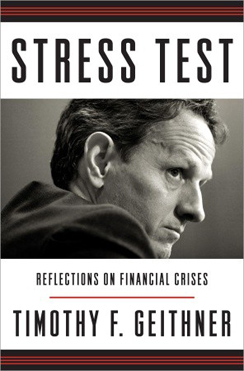Book excerpt: "Stress Test" by Timothy Geithner
The following is an excerpt from "Stress Test: Reflections on Financial Crises" by Timothy F. Geithner. Copyright 2014. Published in the United States by Crown, a division of Random House LLC. Reprinted with permission.
By the summer of 2007, the subprime market was imploding.
I didn't find any of this shocking, or even necessarily unfortunate. The overheated subprime market was overdue for a cooling, and the investors who had bought securities expecting the boom to continue were generally consenting adults. The risk premiums that were now rising across the system had been too low for too long, encouraging too much reaching for yield. It was an absurd sign of the times that "enhanced leverage" had become a selling point for an investment vehicle, instead of a warning; it was like naming a new car model after its faulty brakes. At the Fed's rate-setting meeting on August 7, 2007, I described the turmoil in subprime as "a necessary adjustment, a generally healthy development."
But I also warned the committee that the turmoil had "the potential to cause substantial damage" -- through a contraction in credit, through a liquidity crunch, "through the potential failure of more consequential financial institutions; and through a general erosion of confidence among businesses and households." I noted that investors were losing confidence in their ability to assess risk in mortgage markets, in the market's ability to value complex mortgage securities, and in the rating agencies that had assured them for years that those securities were safe. I also said we were entering a new realm of uncertainty and risk, and "a lot of that risk has gone to leveraged funds that have much less capacity to absorb this kind of shock."
I was more worried than many of my colleagues, but I was not nearly worried enough. Our debate that day was not about whether to cut rates. Unemployment was only 4.7 percent, so the economy didn't seem to need immediate help. Our debate was about whether we should hint that we might cut rates in the future, and most of the committee preferred to wait for more evidence that market disruptions were damaging the economy first. "If we took that approach," I warned, "we'd inevitably be too late." But the group wasn't ready to signal that a future rate cut was likely. In our official statement, the committee noted that "downside risks to growth have increased somewhat," but maintained that increased inflation was still a larger concern than an economic downturn.
I was uneasy. I urged caution. But I didn't clamor for action. I even conceded it would be tricky to temper our public optimism without "feeding the concern . . . about underlying strength in the fundamentals of the economy as a whole or in the financial system." I didn't want to sound too dark too soon.
I didn't have to wait long.
On August 8, I left to see my family on Cape Cod, the same place I had been a decade earlier when the Thai crisis hit. The next day, my staff called to tell me that French bank BNP Paribas, one of the world's largest financial institutions, was suspending withdrawals from three of its investment funds with heavy exposure to the U.S. subprime meltdown. BNP had announced that it couldn't even put a fair price on its subprime-backed securities, citing "the complete evaporation of liquidity" in those markets. Saying the bank had no idea what its subprime assets were worth was much worse than saying the values had declined by 20 or 30 percent. It intensified uncertainty about subprime, as well as other U.S. mortgage-backed securities, and helped to create the larger liquidity crunch I had warned my Fed colleagues about much too gently two days earlier.
Wow. My first response to the news was a string of expletives. I knew Trichet wouldn't put up a wall of money like that on a whim. This wasn't just a little problem on the fringes of the U.S. mortgage market.
I had a sick feeling in my stomach. I knew what financial crises felt like, and they felt like this.
For more info:
- "Stress Test: Reflections on Financial Crises" by Timothy Geithner (Crown); Also available in Large Print Trade Paperback, Unabridged Audio Download and Unabridged Audio CD formats
